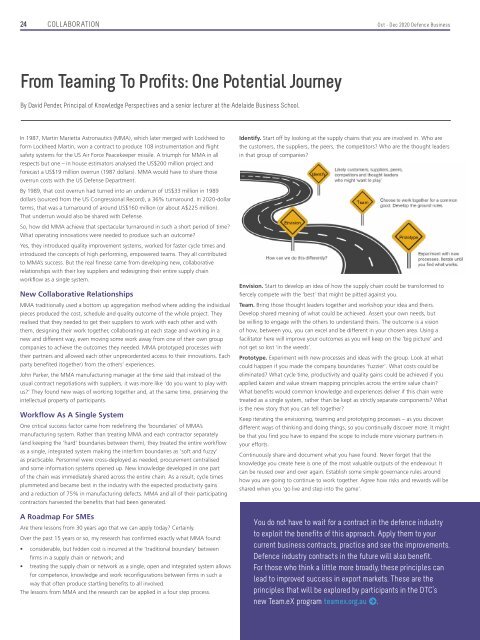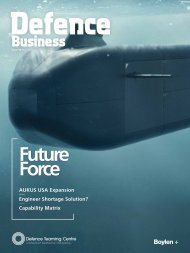Defence Business Issue 52 OCT-DEC 2020
You also want an ePaper? Increase the reach of your titles
YUMPU automatically turns print PDFs into web optimized ePapers that Google loves.
24 COLLABORATION<br />
Oct - Dec <strong>2020</strong> <strong>Defence</strong> <strong>Business</strong><br />
From Teaming To Profits: One Potential Journey<br />
By David Pender, Principal of Knowledge Perspectives and a senior lecturer at the Adelaide <strong>Business</strong> School.<br />
In 1987, Martin Marietta Astronautics (MMA), which later merged with Lockheed to<br />
form Lockheed Martin, won a contract to produce 108 instrumentation and flight<br />
safety systems for the US Air Force Peacekeeper missile. A triumph for MMA in all<br />
respects but one – in house estimators analysed the US$200 million project and<br />
forecast a US$19 million overrun (1987 dollars). MMA would have to share those<br />
overrun costs with the US Defense Department.<br />
Identify. Start off by looking at the supply chains that you are involved in. Who are<br />
the customers, the suppliers, the peers, the competitors? Who are the thought leaders<br />
in that group of companies?<br />
By 1989, that cost overrun had turned into an underrun of US$33 million in 1989<br />
dollars (sourced from the US Congressional Record), a 36% turnaround. In <strong>2020</strong>-dollar<br />
terms, that was a turnaround of around US$160 million (or about A$225 million).<br />
That underrun would also be shared with Defense.<br />
So, how did MMA achieve that spectacular turnaround in such a short period of time?<br />
What operating innovations were needed to produce such an outcome?<br />
Yes, they introduced quality improvement systems, worked for faster cycle times and<br />
introduced the concepts of high performing, empowered teams. They all contributed<br />
to MMA’s success. But the real finesse came from developing new, collaborative<br />
relationships with their key suppliers and redesigning their entire supply chain<br />
workflow as a single system.<br />
New Collaborative Relationships<br />
MMA traditionally used a bottom up aggregation method where adding the individual<br />
pieces produced the cost, schedule and quality outcome of the whole project. They<br />
realised that they needed to get their suppliers to work with each other and with<br />
them, designing their work together, collaborating at each stage and working in a<br />
new and different way, even moving some work away from one of their own group<br />
companies to achieve the outcomes they needed. MMA prototyped processes with<br />
their partners and allowed each other unprecedented access to their innovations. Each<br />
party benefited (together) from the others’ experiences.<br />
John Parker, the MMA manufacturing manager at the time said that instead of the<br />
usual contract negotiations with suppliers, it was more like ‘do you want to play with<br />
us?’ They found new ways of working together and, at the same time, preserving the<br />
intellectual property of participants.<br />
Workflow As A Single System<br />
One critical success factor came from redefining the ‘boundaries’ of MMA’s<br />
manufacturing system. Rather than treating MMA and each contractor separately<br />
(and keeping the ‘hard’ boundaries between them), they treated the entire workflow<br />
as a single, integrated system making the interfirm boundaries as ‘soft and fuzzy’<br />
as practicable. Personnel were cross-deployed as needed, procurement centralised<br />
and some information systems opened up. New knowledge developed in one part<br />
of the chain was immediately shared across the entire chain. As a result, cycle times<br />
plummeted and became best in the industry with the expected productivity gains<br />
and a reduction of 75% in manufacturing defects. MMA and all of their participating<br />
contractors harvested the benefits that had been generated.<br />
A Roadmap For SMEs<br />
Are there lessons from 30 years ago that we can apply today? Certainly.<br />
Over the past 15 years or so, my research has confirmed exactly what MMA found:<br />
• considerable, but hidden cost is incurred at the ‘traditional boundary’ between<br />
firms in a supply chain or network; and<br />
• treating the supply chain or network as a single, open and integrated system allows<br />
for competence, knowledge and work reconfigurations between firms in such a<br />
way that often produce startling benefits to all involved.<br />
The lessons from MMA and the research can be applied in a four step process.<br />
Envision. Start to develop an idea of how the supply chain could be transformed to<br />
fiercely compete with the ‘best’ that might be pitted against you.<br />
Team. Bring those thought leaders together and workshop your idea and theirs.<br />
Develop shared meaning of what could be achieved. Assert your own needs, but<br />
be willing to engage with the others to understand theirs. The outcome is a vision<br />
of how, between you, you can excel and be different in your chosen area. Using a<br />
facilitator here will improve your outcomes as you will keep on the ‘big picture’ and<br />
not get so lost ‘in the weeds’.<br />
Prototype. Experiment with new processes and ideas with the group. Look at what<br />
could happen if you made the company boundaries ‘fuzzier’. What costs could be<br />
eliminated? What cycle time, productivity and quality gains could be achieved if you<br />
applied kaizen and value stream mapping principles across the entire value chain?<br />
What benefits would common knowledge and experiences deliver if this chain were<br />
treated as a single system, rather than be kept as strictly separate components? What<br />
is the new story that you can tell together?<br />
Keep iterating the envisioning, teaming and prototyping processes – as you discover<br />
different ways of thinking and doing things, so you continually discover more. It might<br />
be that you find you have to expand the scope to include more visionary partners in<br />
your efforts.<br />
Continuously share and document what you have found. Never forget that the<br />
knowledge you create here is one of the most valuable outputs of the endeavour. It<br />
can be reused over and over again. Establish some simple governance rules around<br />
how you are going to continue to work together. Agree how risks and rewards will be<br />
shared when you ‘go live and step into the game’.<br />
You do not have to wait for a contract in the defence industry<br />
to exploit the benefits of this approach. Apply them to your<br />
current business contracts, practice and see the improvements.<br />
<strong>Defence</strong> industry contracts in the future will also benefit.<br />
For those who think a little more broadly, these principles can<br />
lead to improved success in export markets. These are the<br />
principles that will be explored by participants in the DTC’s<br />
new Team.eX program teamex.org.au .


















